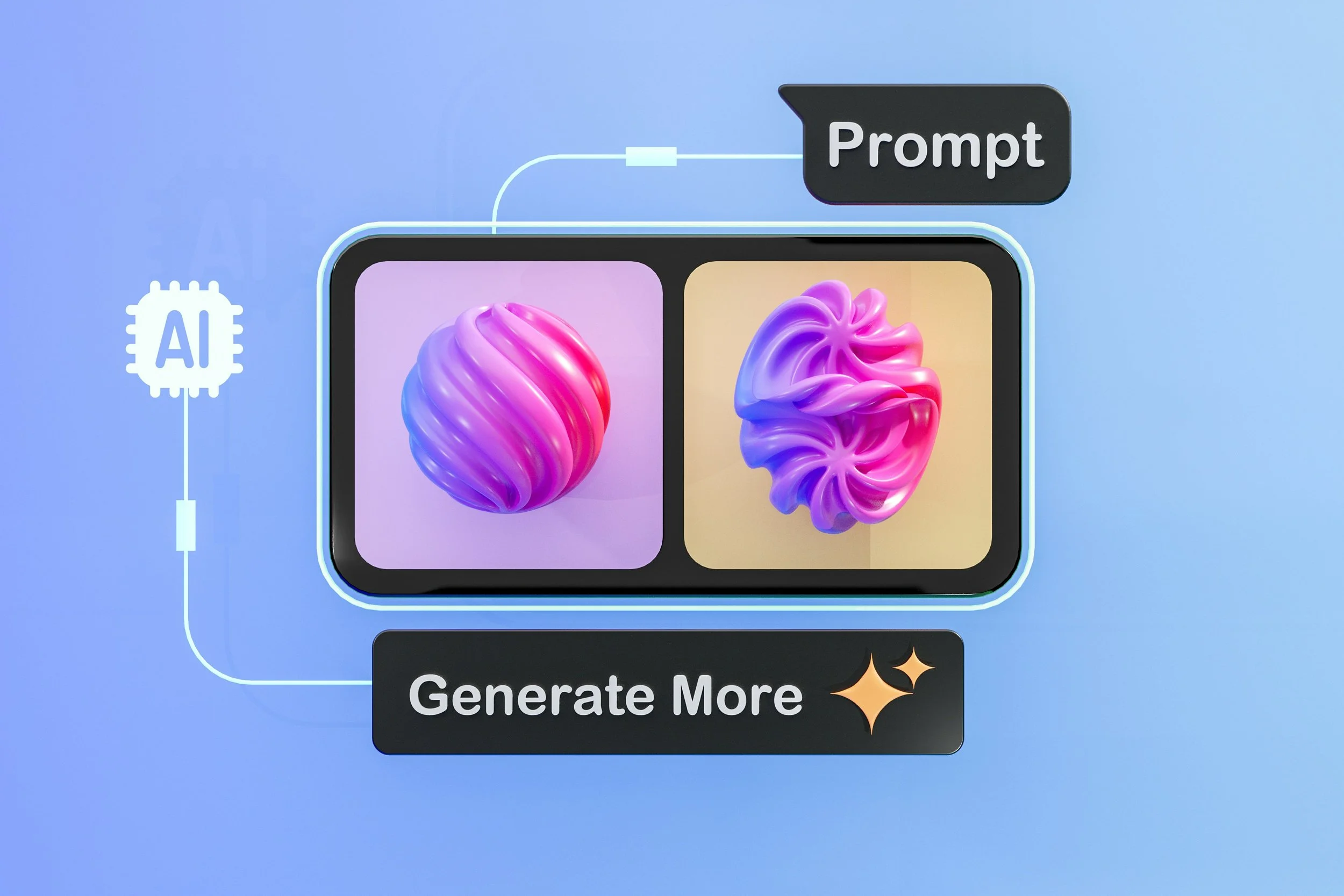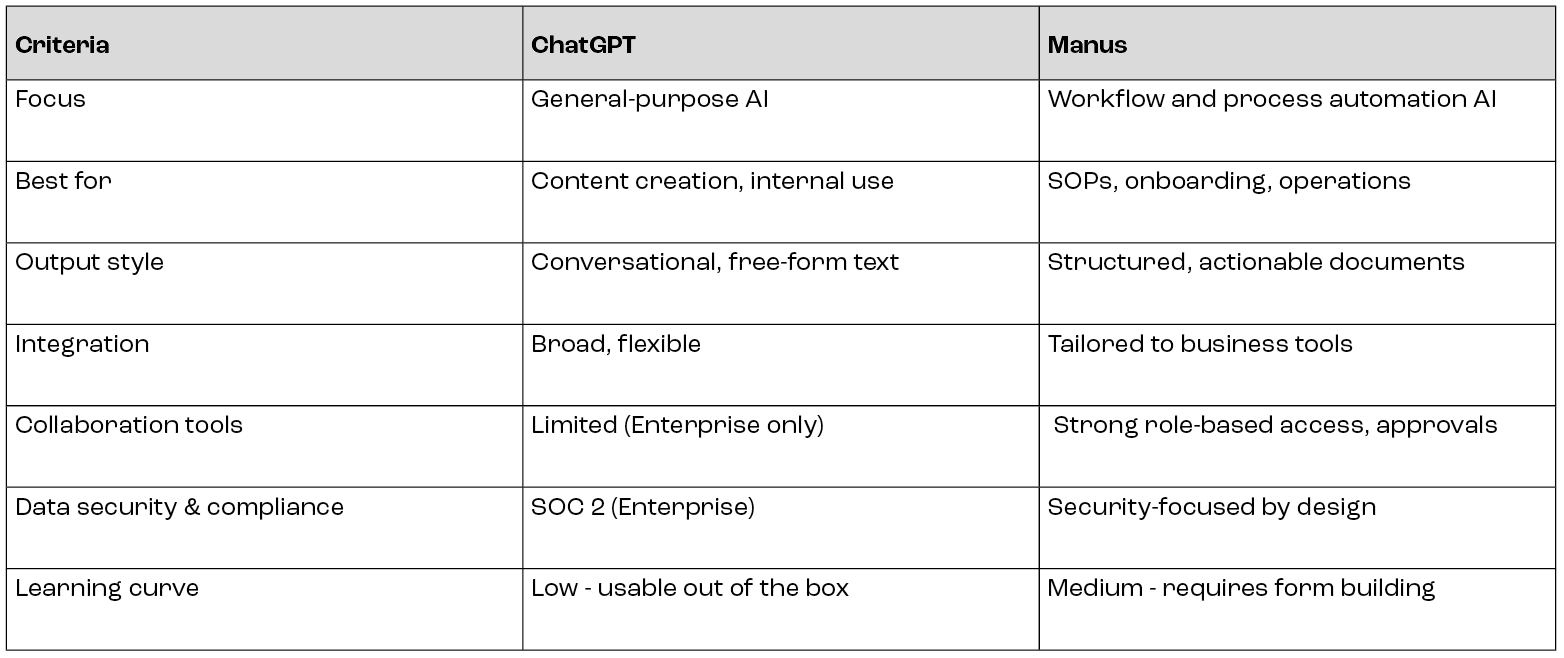ChatGPT vs Manus: Which AI tool is better for business workflows?
Struggling to streamline your operations with AI? Discover whether ChatGPT or Manus is the smarter investment for your business workflows. Read our expert comparison for strategic insights and practical takeaways.
Why this matters: AI is reshaping business workflows
As AI adoption accelerates, businesses are under pressure to find platforms that deliver ROI quickly while integrating seamlessly into current processes.
According to McKinsey's 2023 Technology Trends Outlook, AI adoption has more than doubled since 2017, with over 55% of companies reporting some level of AI integration in operations. The outcome? Improved agility, cost efficiency, and faster execution across departments.
But not all AI tools perform equally. The choice you make can drastically affect your operational scalability, customer experience, and even employee satisfaction.
ChatGPT and Manus each bring different capabilities to the table. Understanding which aligns best with your business scenario can mean the difference between breakthrough results and a clunky implementation.
Let’s unpack how each tool compares in detail.
ChatGPT: A conversational powerhouse for diverse business use cases
If you're in business, you've heard of ChatGPT. Developed by OpenAI, it's a powerful generative language model, designed to deliver human-like responses with astonishing fluency.
From drafting emails and reports to scripting marketing copy or summarising meetings, ChatGPT is widely used for internal productivity and customer-facing roles alike.
Key features and strengths of ChatGPT:
1. Language generation at scale
ChatGPT excels at natural language generation, enabling fast content creation across formats—emails, blogs, FAQs, social media copy and more. This is a game-changer for marketing, HR and operations teams.
2. Integration with tools your team already uses
The launch of ChatGPT plugins and its compatibility with tools like Slack, Zapier, and Excel means businesses can integrate AI into existing workflows with minimal friction. If you're using Microsoft 365 or Notion, you're already close to harnessing its power.
3. Custom GPTs and enterprise control
With ChatGPT Enterprise, companies can customise models to reflect brand voice, industry terminology, and workflow specifics without exposing proprietary data to training. This allows for much more targeted use across departments.
4. Always learning, always evolving
ChatGPT benefits from constant improvements and one of the largest knowledge bases available (based on GPT-4 at the time of writing). This allows it to stay up to speed with digital trends, market shifts, and conversational nuance.
Limitations to consider:
Prone to occasional hallucinations or confidently wrong answers.
Not plug-and-play for complex tasks without prompt engineering.
Data context persists only during active sessions (unless API-connected to data sources).
Best use cases:
Customer service chatbots
Content generation at scale
Internal productivity (emails, meeting notes, task summaries)
Technical support and data analysis (when connected to APIs)
Manus: Workflow-centric AI built for process automation
While ChatGPT is built as a versatile conversational engine, Manus takes a business-native approach. Designed with operational workflows in mind, Manus blends generative AI with built-in task automation, structured documentation, and process mapping.
If your business thrives on repeatable processes, like onboarding, client reporting or SOP documentation, Manus presents a purpose-built solution.
Key features and strengths of Manus:
1. Workflow automation, not just chat
Manus isn't just answering questions—it builds and triggers workflows. From CRM updates to IT ticketing and HR onboarding, Manus bridges departmental silos with automated task orchestration.
2. Structured knowledge management
Manus organises outputs into process maps, SOPs, briefs and templates. Its AI doesn’t just create text, it documents it in business-ready formats you can share, edit, and use repeatedly.
3. Built for collaboration and compliance
Unlike general-purpose AI’s, Manus offers granular permission settings and audit logs, ideal for industries with regulatory obligations or distributed teams collaborating in real time.
4. Integration-ready design
Manus connects with key tools such as Slack, Jira, HubSpot and Google Workspace, eliminating the need for constant tab-switching. This allows seamless creation, execution, and monitoring of workflows in one place.
Limitations to consider:
Less suitable for narrative-heavy content like blogs or social copy.
Requires more upfront configuration to model internal processes.
Smaller knowledge base than ChatGPT for conversational breadth.
Best use cases:
Business process documentation and automation
SOP creation, project briefs and internal documentation
Interdepartmental workflows (e.g., legal + sales handoffs)
AI-guided onboarding for employees or clients
Key comparison: ChatGPT vs Manus in real business scenarios
To help you decide which to use - or if a hybrid approach suits your needs better. Here’s a side-by-side breakdown of key decision factors.
Practical strategies: How to choose and implement the right AI tool
1. Match the tool to the task
Use ChatGPT when you need quick, versatile content assistance—email templates, copywriting, explanations. Lean on Manus when you're codifying a process or want to automate handoffs between teams.
2. Start small before scaling
Pick a use case with high manual load but low risk. Examples: automating a welcome email series (ChatGPT) or documenting your social media approval process (Manus). Validate value, gather feedback, and iterate.
3. Build “Human in the loop” safeguards
Both tools benefit from human oversight. Build your workflows so a team member can approve or edit AI-generated outputs, especially in sensitive or regulated industries.
4. Train your team
AI tools are only as effective as the people using them. Run short workshops to upskill your teams in prompt design (for ChatGPT) or process mapping (for Manus).
5. Integrate into your ecosystem
Use API connections or platform integrations to ensure the tool interacts with your existing stack, including CRM, ticketing, project management and HR tools.
6. Measure ROI over time
Use KPIs such as hours saved, errors reduced, or process completion time to measure ROI. Both Manus and ChatGPT provide analytics or can integrate with data dashboards for tracking performance.
Final takeaway: Collaboration between tools may be the sweet spot
While ChatGPT and Manus serve different purposes, they are not necessarily competitors. In fact, many agile businesses integrate both. Imagine this workflow:
Use ChatGPT to create training materials or email copy.
Use Manus to automate distribution and embed that training into onboarding workflows.
Result: faster execution, consistent outputs, and freed-up team bandwidth.
Ultimately, the right choice depends on your team's maturity with AI, the nature of your operations, and your appetite for automation.
For startups needing flexible productivity at pace - ChatGPT shines.
For scaling organisations aiming to standardise processes and reduce human error - Manus may be the better long-term solution.
Time to make the AI leap? We can help
At Otter Labs, we help startups and scale-ups integrate AI solutions that accelerate operations and deliver bottom-line impact. Whether you're exploring ChatGPT prompts or building structured workflows in Manus, our team can guide you through setup, scale and beyond.
Get in touch for a free AI workflow consultation - or check out our latest case studies showing how AI-enablement delivered measurable gains across marketing, operations and finance.
Because in business, working smart beats working hard and with the right AI tools, you can do both.
Are you AI Ready? Receive your customised AI plan





